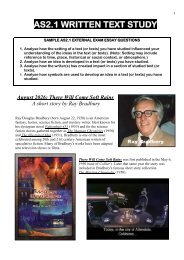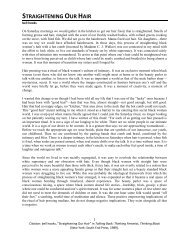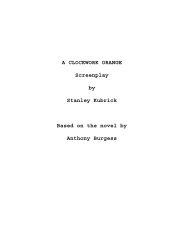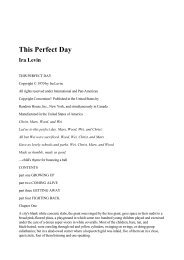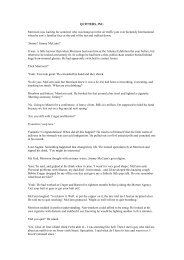9780415317856_the_routledge_creative_writing_coursebook
9780415317856_the_routledge_creative_writing_coursebook
9780415317856_the_routledge_creative_writing_coursebook
You also want an ePaper? Increase the reach of your titles
YUMPU automatically turns print PDFs into web optimized ePapers that Google loves.
www.ATIBOOK.irPoetry 65moving from tree to tree,his blood (channeled nowthrough Dacron tubing)beating strong again in his chest,while overhead <strong>the</strong> blue nor<strong>the</strong>rn skystares down, intentas a surgeon’s great solemnscrutinizing eye—under <strong>the</strong> hot floodlights of spring.(Wilkins, 1982:38)The cherries ripen under a hot blue sky, and healing seems a natural process, but <strong>the</strong> lastlines correct that impression. The process involves <strong>the</strong> heavy engineering of <strong>the</strong> operatingroom with its overhead power-lamps. The poem brings <strong>the</strong> mechanical and naturaltoge<strong>the</strong>r in one stunning metaphor: ‘<strong>the</strong> hot floodlights of spring’. Despite <strong>the</strong>ir gradualconvergence we experience this final conjunction as a shock. Just at <strong>the</strong> moment whenwe thought of spring as <strong>the</strong> healing force, we are reminded of <strong>the</strong> surgeon’s eye.However strong <strong>the</strong> recovery was, a sense of being assailed still continues. The poemcouldn’t produce this insight without details of setting or world, without image (<strong>the</strong> waycolours impinge with forceful clarity), and story—from illness to recovery. We hear ofrecovery, also of persistent exposure, a turning-point that doesn’t quite make <strong>the</strong> turn, ofgreen orchards, also Dacron tubing. A dramatic tension holds <strong>the</strong>se impressions toge<strong>the</strong>r.TransmittersBut something else is important here and that is <strong>the</strong> poem’s relationship with its world. Inthis poem <strong>the</strong> cherries aren’t <strong>the</strong>re just to provide realistic touches and <strong>the</strong>refore credulity,not used just to brighten its colour spectrum. They are performing a central function inthis particular machine of words. More than objects, <strong>the</strong>y appear as transmitters ofmeaning, become signals of colour, an awakened sensuous ness, sought for as anaffective supply of life. What sort of cherries, how many, how red, etc? Just to describe<strong>the</strong>m statically in terms of size and shape, along with everything else, is not <strong>the</strong> point. Bytransmitter, what I mean is that a particular object doesn’t just receive special attention, itgalvanises <strong>the</strong> rest of <strong>the</strong> poem’s world, generates a force field, a polarisation of energy.If you describe it you will be doing more than just representing an object in words. Itssignals seem to steer <strong>the</strong> attention we give to <strong>the</strong> poem as a whole, and to a widermeaning as we read. A transmitter can be a person or an object, animate or inanimate, astreet sign, something in a landscape. If poems are dramatisations of experience, <strong>the</strong>n oneway of enhancing that drama will be to think not of static scenes but of shaping energy.Examples of transmitter poems include ‘The Tyre’ by Simon Armitage, many ofSylvia Plath’s poems, particularly ‘Tulips’ from Ariel, ‘A Disused Shed in CountyWexford’ by Derek Mahon, is ano<strong>the</strong>r. The following poem by Daniel Weissbort, a poet




